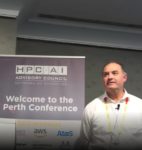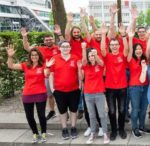Allan Williams from NCI gave this talk at the Perth HPC Conference. “With 3,200 nodes, Gadi will power some of Australia’s most crucial research, seeking to solve some of the most complex and pressing challenges facing the world currently. Researchers from organizations including the CSIRO, Geosciences Australia, and the Bureau of Meteorology will benefit from faster speeds and higher capacity compared to the existing supercomputer.”
ISC High Performance: Fueling Innovation & Fostering Family for 33 Years
In this special guest feature, Elizabeth Leake from the STEM-Trek Nonprofit reflects on inclusivity at the recent ISC 2019 conference in Frankfurt. “A favorable experience means that attendees are more likely to return. And they do; this year, 164 exhibitors and 3,573 attendees from all domains and 64 countries were there. Attendance has doubled since 2009 and grows at a comfortable pace each year.”
Meet the Winners of the Student Cluster Competition from CHPC in South Africa
In this video, Dan Olds interviews the overall winners of the ISC 2019 Student Cluster Competition from CHPC in South Africa. “With this win, CHPC has now taken home the ISC Overall Championship an astounding four times, pulling even with Tsinghua in number of ISC championships. CHPC also maintained their record of reaching the podium in each of their seven cluster competition outings.”
Announcing the Student Cluster Competition Leadership List
The HPC-AI Advisory Council Dan Olds have just posted the first-ever Student Cluster Competition Leadership List. “The list is a ranking of every institution that has ever competed in a cluster competition. The teams are ranked by the number of times they’ve participated and the awards they’ve earned throughout the years. It covers every cluster competition including the ISC competition in Europe, the SC competition in the US, and the Asian competition in China.”
40 Powers of 10 – Simulating the Universe with the DiRAC HPC Facility
Mark Wilkinson from DiRAC gave this talk at the Swiss HPC Conference. “DiRAC is the integrated supercomputing facility for theoretical modeling and HPC-based research in particle physics, and astrophysics, cosmology, and nuclear physics, all areas in which the UK is world-leading. DiRAC provides a variety of compute resources, matching machine architecture to the algorithm design and requirements of the research problems to be solved.”
Swiss HPC Conference to Focus on Intersecting Interests, Industries, and Initiatives
Coming up in April, AI and HPC practitioners share passions for cutting-edge technology and breakthrough R&D in Lugano, Switzerland at the tenth annual Swiss Conference and HPCXXL User Group. The joint sessions take place at Palazzo dei Congressi, April 1-4, bringing leaders together from academia, government and industry to share first-hand insights on innovative research, techniques, tools and technologies that are fueling economies, productivity and progress globally.
Announcing the 2018 HPC-AI Competition in APAC
Today the HPC AI Advisory Council announced the 2018 APAC HPC-AI Competition. Co-sponsored by National Supercomputing Centre in Singapore, the 2018 APAC HPC-AI Competition will start on March 27, 2018 and continue until August 2018. “The APAC HPC-AI competition encourages international teams in the APAC region to showcase their HPC and AI expertise in a friendly yet spirited competition that builds critical skills, professional relationships, competitive spirits and lifelong comraderies. The competition is open to university and technical institute teams from the entire APAC region, and includes both creating missions and addressing challenges around AI development and testing, and high-performance computing workloads.”
High Availability HPC: Microservice Architectures for Supercomputing
Ryan Quick from Providentia Worldwide gave this talk at the Stanford HPC Conference. “Microservices power cloud-native applications to scale thousands of times larger than single deployments. We introduce the notion of microservices for traditional HPC workloads. We will describe microservices generally, highlighting some of the more popular and large-scale applications. Then we examine similarities between large-scale cloud configurations and HPC environments. Finally we propose a microservice application for solving a traditional HPC problem, illustrating improved time-to-market and workload resiliency.”











